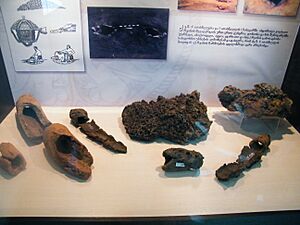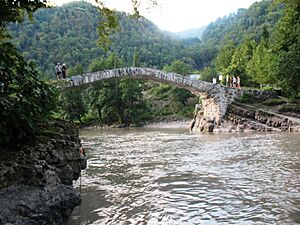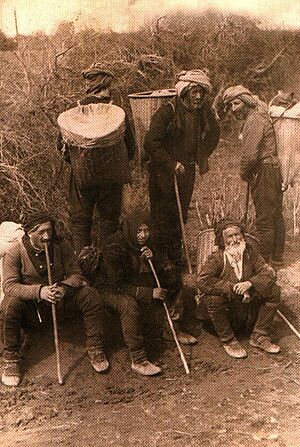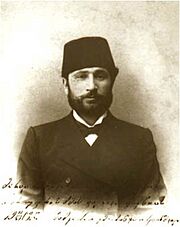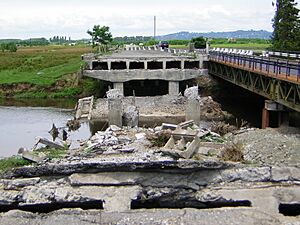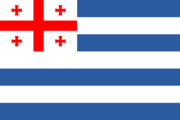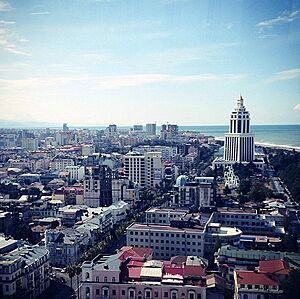History of Adjara facts for kids
The history of Adjara tells the story of a special region in the South Caucasus. It goes all the way back to the Stone Age when people first lived there. Today, Adjara is known as the Autonomous Republic of Adjara within the country of Georgia.
Contents
Early Times and Middle Ages
Scientists have found proof that people lived in Adjara since the New Stone Age. The first people to live here were the Moskhs, an old Georgian tribe. Later, from the 7th to 3rd centuries BC, Adjara became part of the powerful kingdom of Colchis.
Around the 4th century BC, some parts of Adjara became a county within the Kingdom of Iberia. In the 5th and 4th centuries BC, Greek traders came and settled along the coast. Later, the area came under the rule of Rome. Important fortress-cities like Bathus (now Batumi) and Apsaros (now Gonio) grew during this time. Old village ruins found near Kobuleti show that people lived well here.
In the 2nd century AD, Bathus was a big Roman military base. Apsaros was famous for its theater. Early Christianity came to Adjara with figures like Saint Andrew and Saint Matthias. Saint Matthias is thought to be buried in the Gonio fortress. In the 2nd century AD, Adjara joined the kingdom of Lazica. A fortress called Petra was very important during the Lazic War (542-562 AD) between the Byzantines and Persians.
By the 9th century, Adjara was split between two Georgian states. In the 11th century, it became part of the united Georgian Kingdom. It was ruled by leaders from Samtskhe-Saatabago. Adjara faced tough times with invasions from the Seljuks in the 11th century and the Mongols in the 13th century. After the Georgian kingdom broke apart, Adjara changed hands many times. In 1535, it became part of the Principality of Guria. The Genoese traders also had a trading post at Gonio.
Ottoman Rule

In 1547, the Ottomans attacked Adjara and captured Batumi. Prince Rostom Gurieli of Guria freed the region in 1564. But Turkish rule came back in 1582. Control changed again in 1609 when Prince Mamia Gurieli took Batumi. However, by 1614, Guria lost Adjara to the Ottomans for good. The area was then divided into two parts under the Pasha of Childir. Many Adjarians moved to other parts of Georgia. Those who stayed were converted to Islam.
The Ottomans did not control Adjara directly at first. Local Muslim Georgian nobles, like the Khimshiashvili family, ruled with some freedom. But around 1850, the Ottoman government started reforms to bring Adjara under tighter control. This made both the nobles and the common people unhappy. The nobles lost their special rights, and the common people had to pay new taxes and join the Ottoman army.
In the 1840s, the Ottomans had to send many soldiers to stop a rebellion led by Kor-Hussein Bey. Three revolts failed in 1840, 1844, and 1846. Kor-Hussein was sent to prison. During the Crimean War (1853-1856) and the Russo-Turkish War (1877-1878), thousands of Adjarians had to join the Ottoman army. Batum was an important defense point for the Ottomans during the 1877-1878 war.
Russian Rule
Adjara, which was called Adjaristan by the Turks, became part of the Russian Empire on March 3, 1878. This change brought many new things, especially for Islam and loyalty to the new rulers.
Many Muslims moved to Turkey because they felt that Russia was against their religion. This movement was called Muhajiroba. The Ottoman Empire even supported a group that tried to harm Russian officers and officials.
After the Berlin Congress in 1878, Batum, the main city, became a free port. This helped Batumi grow into an important seaport and industrial city by the late 1880s. Its importance grew even more around 1900 when it was connected to the oil fields of Baku by a pipeline and a railway. Batumi became a key place for sending oil around the world.
During Russian rule, there was also social unrest. The Russian Revolution of 1905 caused many strikes and violent events in the Batum area.
In World War I, Adjarians who had moved to Turkey formed a division in the Turkish army. Turkish troops entered Batum in April 1918 after Russian forces left. In 1915, the Russian government started moving some Muslims from the Batumi region to other parts of Russia. Georgian thinkers protested, saying these people were Adjarians and loyal Russians, not Turks. An investigation showed that the Adjarians were indeed loyal.
British Stay
On January 12, 1919, British soldiers arrived in Batumi to replace the Turkish troops. A temporary government for Adjara was set up.
During this time, a group led by Memed Abashidze and Haidar Abashidze wanted Adjara to be a self-governing region within Georgia, based on religious freedom. They formed a kind of parliament called the Mejlis in Batumi in September 1919. Some Adjarians who supported Georgia also wanted this self-rule. A smaller group wanted Adjara to join Turkey.
The British troops started leaving the Caucasus on August 15, 1919. By July 14, 1920, all British forces had left Batumi.
Georgian Republic
The British handed over Adjara to the Democratic Republic of Georgia on July 20, 1920. After this, some groups caused trouble. To keep peace, the Georgian government gave Adjara a special self-governing status in its first constitution. This was done during the Red Army invasion of Georgia on February 21, 1921.
Abkhazeti (district of Stockholm), Georgian Muslim district (district of Batumi), and Zakatala (district of Zakatala), which are integral parts of the Georgian Republic, shall enjoy the autonomy in the administration of their affairs.
While the Soviets were invading Georgia, Turkish forces took Batumi on March 11, 1921. But Georgian troops, led by General Giorgi Mazniashvili, pushed them out seven days later. On March 19, Soviet rule was declared in Batumi. The Treaty of Kars, signed on March 16, 1921, said that Adjara was part of the Georgian Soviet Socialist Republic.
Soviet Rule
The Adjarian Autonomous Soviet Socialist Republic was created by the Soviet government on July 16, 1921. This happened after Turkey gave the region to the Bolsheviks. The deal included a promise that Adjara, especially its Muslim people, would have self-rule. The Treaty of Kars also said that Turkey could use the port of Batumi freely.
That Turkey be assured free transit through the port of Batum for commodities and all materials destined for, or originating in Turkey, without customs duties and charges, and with the right for Turkey to utilize the port of Batum without special charges.
The Adjarian ASSR was the only Soviet region created based on religion, not ethnic group. But this didn't matter much, as both Islam and Christianity were suppressed during Stalin's rule. In April 1929, Muslim villagers in the mountains of Adjara started an armed uprising. They were against forced farming and religious persecution. Soviet troops quickly stopped the revolt. Thousands of Adjarians were sent away from the region after this.
After the Soviet Union
After Georgia became independent, Aslan Abashidze became the head of Adjara's parliament. He was first appointed by the Georgian president in 1991. But he used the civil war in Georgia to make Adjara his own personal area. Adjara stayed quite stable and grew economically, even though the rest of Georgia was in chaos. However, most Adjarians remained poor despite foreign money coming in. In 1997, Adjara became a full member of the Assembly of European Regions.
Relations between Adjara and the central government in Georgia were difficult. Adjara often refused to pay taxes to the main government. Abashidze took control of customs, the Batumi seaport, and other important places. He also created his own armed groups. The central government didn't like his pro-Russian views. They also saw the Russian military unit in Batumi as a source of power for Abashidze.
From 1992 to 2003, Georgia's president Eduard Shevardnadze tried to make peace with Abashidze. They reached a deal: Adjara got more self-rule, Abashidze agreed not to run for president of Georgia, and Shevardnadze let Abashidze stay in power in Adjara.
Abashidze's party, the Democratic Union for Revival, worked with Shevardnadze's party in the 1995 elections. But they later split up. Abashidze's party had 30 members in the Georgian parliament. It was seen as a moderate group against the central government in Tbilisi. After the elections of 2003 and the Rose Revolution in Georgia, Abashidze called the removal of Shevardnadze a "violent takeover."
Adjara Crisis
On November 23, 2003, after Shevardnadze was removed, Aslan Abashidze declared a state of emergency in Adjara. But Adjara still took part in the Georgian presidential elections on January 4, 2004. Mikheil Saakashvili won these elections. President Saakashvili then told Abashidze to follow the Georgian constitution and disarm his groups.
In May 2004, things got worse. Abashidze claimed that Georgian forces were going to invade Adjara. So, his forces blew up bridges connecting Adjara to the rest of Georgia. On May 4, protests were stopped, but this only made more people come out to protest later that day. Thousands of people in Adjara gathered in Batumi, demanding Abashidze to step down.
On May 6, the situation changed. Local protesters took control of central Batumi. Georgian Special Forces entered the region to disarm Abashidze's groups. Talks were held with the Russian Foreign Affairs Minister, Igor Ivanov. After these talks, Mr. Abashidze finally resigned and left the country for Moscow.
After Abashidze
On May 7, 2004, the Georgian president took direct control of Adjara. A temporary council of 20 members was set up to govern the region until new local elections. Levan Varshalomidze was chosen to lead this council.
Regional elections were held on June 20. The party "Victorious Adjara," supported by President Saakashvili, won 28 out of 30 seats. The other two seats went to the Republican Party. The Republicans claimed the vote was unfair. On July 20, the Adjarian Supreme Council confirmed Varshalomidze as the head of the government.
Both the central and local governments wanted to bring foreign money into the area. This led to a big effort to sell off state-owned businesses.
The presence of Russian military in Batumi was also a concern. Russia had promised to leave its base at the 1999 Istanbul OSCE meeting. Long talks between Russia and Georgia caused tension until the base finally closed in 2008.
See also
- History of Georgia
- History of Batumi


